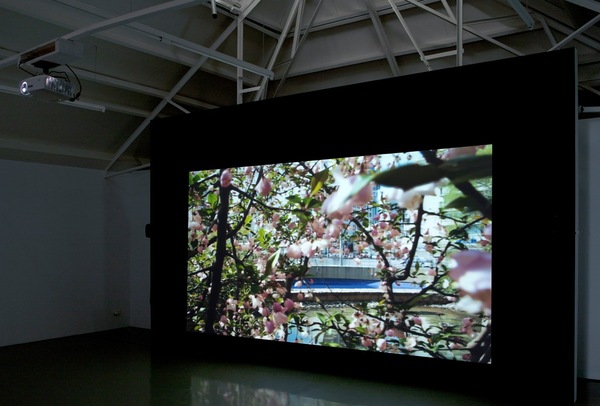From the perspective of a panther looking for prey, awkwardly hiding behind urban foliage, Gabriel Lester filmed and photographed the streets. Leaves of trees, ivy, and blossoms dominate his images while the tarmac, cars, and people in the background continue on with their days. Lester quietly observes non-spaces while the world passes him by.
Why?
Flicking though Lester’s monograph How To Act, I couldn’t help but notice an obsession with the mundane. His installations, captured in photographs and video works, show plants stuck in offices and people stuck in homes. For example Seen (2006), a work shown at the Bonniers Konsthall in Stockholm, comprised six wall projections depicting rooms filled with people, often slouching on cheap sofas, drinking fizzy pops. The tension between the observer and the observed in Seen is similar to the one present in his current work. We, as viewers or second-hand observers, are made to feel as if we are secretly watching other people’s lives. Lester’s subjects are uneventful, boring even. Nevertheless, the artist keeps watching from a distance, bordering perversity, without ever taking part. Like a shy kid on a playground, or a not entirely uncreepy voyeur, hidden somewhere across the street.

Gabriel Lester, The Secret Life of Cities, 2013, two channel video installation, 14 min (loop); Photo: Gert Jan van Rooij; Courtesy of the artist and Galerie Fons Welters.
Is Lester merely observing, and showing us the often overlooked? Or is his message more moralistic? Is he trying to make us see what we’ve done to the world? What boring beasts we have created?
In his new series one can see, apart from the focus on the mundane, another story evolving: a story about the green. Predating this exhibition, Lester published on his website a text titled One – End in which he expresses admiration for pioneers of self-sufficiency: Henry David Thoreau, John Seymour, Claire Wolf. He describes a fictional movie in which these people, as characters “are shown […] in a world of their own, alone, roaming abandoned, desolate cityscapes, overgrown by wild vegetation and inhabited by even wilder animals…”

Perhaps the images in The Secret Life of Cities are a visual testimony to Lester’s fascination with a different societal structure, a place where people are not bound or addicted to the urban environment, but one in which man – and nature – are roaming and growing free. The leaves in Lester’s images, which often look dull, grey and dusty, clearly tired from the overdose of carbon dioxide they’ve just inhaled, could be seen as lost patches of wilderness, and the ratio in which they are shown – clearly taking up more space than the concrete jungle around them – suggests a cityscape which is not largely concrete, but largely overgrown.
Lester leaves all of this in the middle, and for us to figure out. And while we’re left pondering his intentions, he’s most likely to be out on his knees somewhere, behind some city’s green spot, watching how the day’s traffic drives off into the night.
(Image on top: Gabriel Lester, The Secret Life of Cities, 2013, installation view; Photo: Gert Jan van Rooij; Courtesy of the Artist and Galerie Fons Welters.)